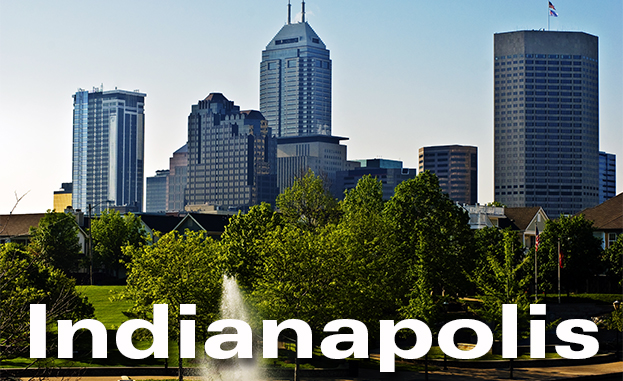
Indianapolis is considered the “Crossroads of America” and is the capital of Indiana. It has a diversified and expanding $120 billion economy fueled by health care, education, entertainment and manufacturing. Tourism is becoming a more vital part of the economy as the city plays host to numerous conventions and sporting events. The city is home to several higher education institutions and expanding health care facilities. The downtown is consistently evolving and the region is well known as an affordable place to live. Forbes ranked Indianapolis among the best downtowns in the United States. It is home to a FedEx hub and numerous distribution centers like Amazon.com and Target. The region has very low unemployment with a rate of 5%. Indy has low rental vacancy rates (8%) and attractive low acquisition prices ($50,000-$70,000) for single-family homes creating 10%+ cap rates and 20%+ cash-on-cash returns making it a solid income-producing region.
INVESTOR SCORECARD

AT A GLANCE
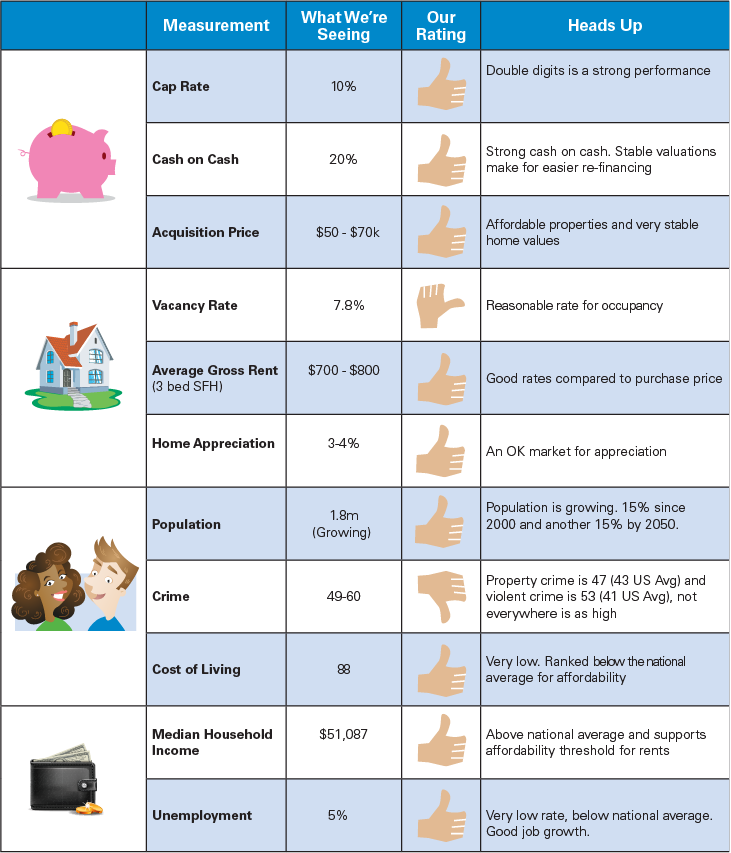
This material is based largely upon work supported by public data. You should not assume any investment made using any of this research would be without risk or meet your investment goals. You should check all facts for yourself. Any opinions, findings, conclusions, or recommendations are those of the author and provided without warranties of any kind either expressed or implied.
REGIONAL STATS
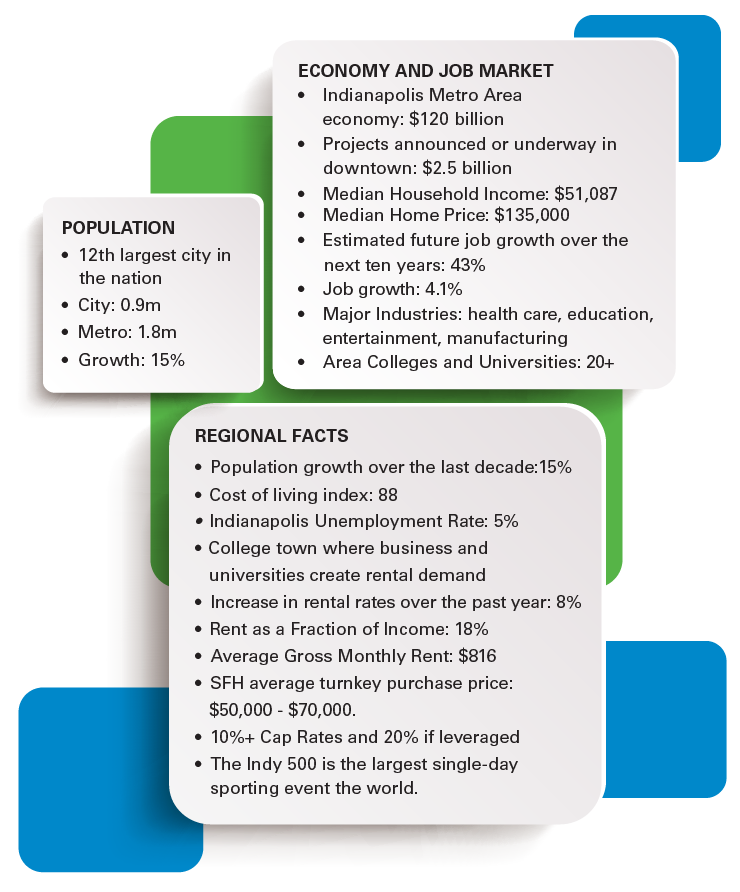
MARKET OVERVIEW
Both Forbes and Livability.com rank Indianapolis among the best downtowns in the United States citing "more than 200 retail shops, more than 35 hotels, nearly 300 restaurants and food options, movie theaters, sports venues, museums, art galleries and parks" as attractions. Indianapolis is a prime center for logistics and distribution facilities thanks to its five interstates (I65, I69, I70, I74, and I465), five railroad systems, its central access located in the heart of Indiana, the recent $1 billion Indianapolis Airport. It is home to a FedEx Express hub and distribution centers for companies such as Amazon.com, Fastenal, Target, and CVS Pharmacy. The population of the metropolitan statistical area was 1.8 million according to the 2010 U.S. Census, making Indianapolis the 12th largest city in the United States.
The median income for a household in the metropolitan area is $51,087. The unemployment rate is a healthy 5%. With low home prices and high rental occupancy rates it presents opportunities for turnkey single-family homes at around $50,000-$70,000 cash flowing $5,000–$7,000 annually.
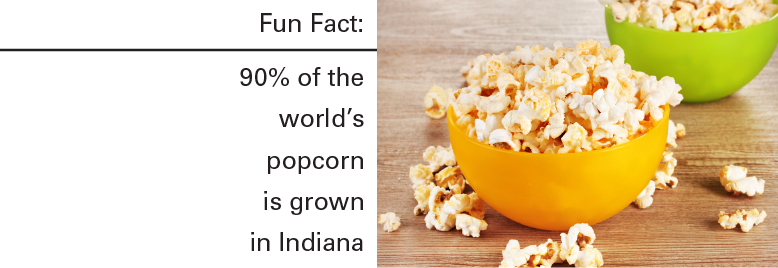
Economy
The region’s largest industry sectors by employment in Indianapolis are manufacturing, health care, education, logistics, retail trade and entertainment. Forbes magazine recently ranked Indianapolis the 6th best city for jobs. In 2010, Indianapolis was rated the 10th best city for relocation by Yahoo Real Estate and 10th among U.S. metropolitan areas for GDP growth. Indianapolis was also ranked first on CNN/Money's list of the top 10 cities for recent graduates.
Regional Redevelopment: Eds and Meds and Sports!
Downtown Indianapolis has come a long way in the past few decades, creating Indiana’s center of commerce, government, medicine and education. Downtown has become a national success story with its growth of tourism, sports, arts and entertainment. Since 1990, more than $9.6 billion of public and private funds have been invested in downtown Indianapolis, according to Indianapolis Downtown, Inc. (IDI), averaging more than $436 million annually for the past 22 years and resulting in more than 525 projects. What’s important here is the allocation of these funds for hospitals and the university Indiana University-Purdue University Indianapolis (IUPUI), or the so-called “eds and meds,” accounting for over half of the investment. Sports and entertainment facilities, the convention center, convention hotels, and Circle Centre mall, accounted for just over a quarter.
In addition, a recent five-year strategic action plan called “Velocity” has been developed for downtown with over 60 projects scheduled for completion by 2017 according to IDI. The revitalization and investment opportunities continue.
Education and higher learning abound throughout and around Indianapolis, creating a constant stream of new companies, entrepreneurial opportunities, and qualified employees. The state of Indiana is fortunate to have Notre Dame, Indiana University, Purdue University, IUPUI, Butler and Ball State just to name a few universities.
Indiana University and IU Health entities alone are huge engines for growth in the region contributing $11.5 billion annually to the state economy. IU and IU Health combined represent 4.5% of the total Indiana economy and, when taken together, are the state's largest employer, accounting for 48,147 direct jobs, as well as another 51,844 indirect or induced jobs.
Overall healthcare drives a $31.3 billion economic impact to the state with 35% of all those jobs being in the Indianapolis/Carmel metropolitan area according to a report prepared by Battelle Technology Partnership Practice. In 2013 for example the brand-new $754 million Eskenazi Hospital opened (pink area east of river and few blocks north west of IU Health University Hospital on map below). Health venture capital is growing, too, with Indiana’s start-up health care companies attracting $104 million in investments in 2014.
IU Healthcare Locations

In addition to “Eds and Meds” major attractions throughout Indianapolis support the region’s 26 million annual visitors, who spend roughly $4.4 billion, employing 74,000 full-time equivalent employment positions. These include but are not limited to the Indianapolis Colts, Indiana Pacers, Indiana Fever, NCAA Headquarters, Indianapolis Motor Speedway (IMS), White River State Park, Indianapolis Zoo and The Children’s Museum. Research shows that IMS generates over $500 million of economic activity annually in the region.
This region has created a diversified economy with major contributions from education, health care, entertainment and logistics with healthy job growth and employment opportunities. Unemployment is low in the region with the rate peaking in January 2010 at 9.4% and is now 4.4 percentage points lower at 5%.
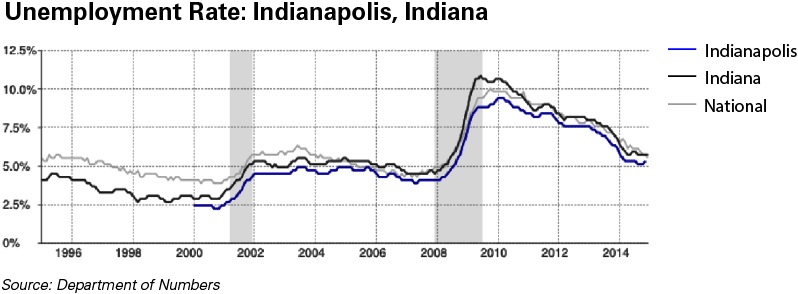
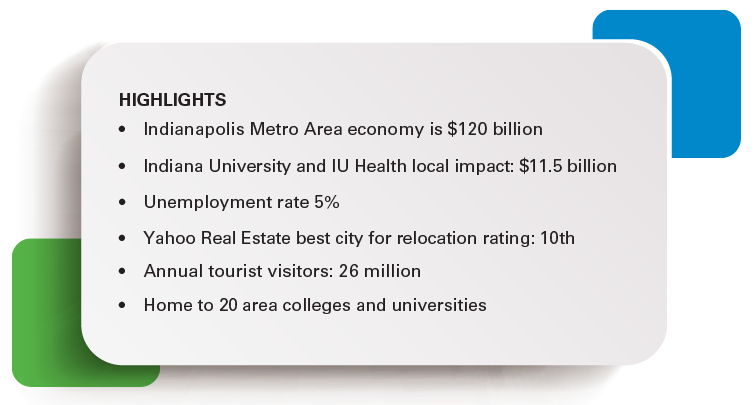
IMPORTANT QUESTIONS
Will It Rent?
We’ve been watching the region and there are some positive trends toward investment properties right now. The low price of inventory compared to other metropolitan areas combined with low unemployment and low vacancy rates are especially appealing. The rental vacancy rate is the fraction of homes for rent that are not occupied. The rental vacancy rate in Indianapolis peaked in 2006 at 13%. Since then it has fallen to 7.8% in 2013, according to U.S. Census data.

What Do Tenants Pay?
The average monthly gross residential rent in Indianapolis was $816 in 2013. We like 3 bedroom single-family homes and the rent fees for 3 bedrooms appear stable around $700 - $800 per month.
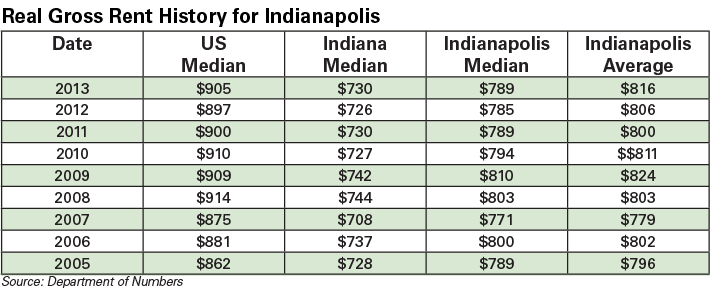
What About Home Values?
Indianapolis is a region known for affordable homes. Homes in the area appreciated 6.4% in 2014. However, over the course of three years, Indianapolis homes appreciated by as much as 16.9%. Homes may well see an increase in appreciation from continued investment in the region. In this uneven housing recovery, markets will take time to make it back to pre-recession levels. It is reasonable to assume that forecasts made for overall U.S. metro markets of 3-4% appreciation could be applied to Indianapolis investments given employment growth, market prices and unemployment rates.
There is an opportunity at the $50,000 - $70,000 price point for fully rehabbed single-family homes. The average price per square foot in Indianapolis is $72. The median sales price for homes at the end of 2014 was around $135,000
What About the Population?
As of 2014, Indianapolis Metro Area’s population is 1,759,791 people. Since 2000, it has had a population growth of 15.5%. The city of Indianapolis (Marion County) boasts 918,977 people and is the 12th largest city in the U.S. It’s predicted the entire state of Indiana will grow 15% by 2050, and populations in counties surrounding Indianapolis are expected to grow the most. The Indianapolis-Carmel metro area has always been the growth engine for the state, and accounted for 57% of Indiana’s growth between 2000 and 2010. By 2030, it’s expected to be responsible for 62% of the state’s growth.
What About Crime?
Indianapolis’ property crime is 49 from a scale from 1 (low) to 100. Property crime includes the offenses of burglary, motor vehicle theft and arson. The object of the theft-type offenses is the taking of money or property, but there is no force or threat of force against the victims. The U.S. average is 43. Indianapolis’ violent crime is 60 on the same scale from 1 (low crime) to 100. Violent crime is composed of four offenses: murder/manslaughter, rape, robbery and aggravated assault. The U.S. average is 41.
Where Do We Like?
Investing in real estate in Indianapolis will likely continue to offer great deals in the short term for turnkey properties or fix/flip and hold or wholesale in the communities that are relatively close to downtown and the eds, meds and sports facilities. Two generations dominating Indianapolis are the older Baby Boomers and younger Millennials who place premiums on mobility, education and health options resulting in households choosing to live in walkable/bikeable neighborhoods with good public transportation. It’s clear that high cash flowing properties are becoming much harder to find, but there are some investment belts where we feel there is opportunity for decent returns. Remember, neighborhoods change block by block so make sure you do you homework and diligence. Here are some areas we hear investors like right now:
Bates-Hendricks
Bates-Hendricks is an up-and-coming neighborhood near the south side of Indianapolis. With an active neighborhood association, project grants from the Lilly Foundation, and recognition from the City of Indianapolis, Bates-Hendricks is poised for rejuvenation. Ideally situated near downtown, Fountain Square and Garfield Park, the neighborhood is close to numerous restaurants, businesses and recreational facilities. Cyclists can easily commute to downtown via East Street’s bike lanes, a branch of Indianapolis’ growing bike lane infrastructure. With nearby access to I-65 and I-70 almost any location in Indianapolis is just minutes away. Homes in this area can still be acquired for under $60,000. It is one of the few areas where you can earn double-digit net returns on rentals and still anticipate good appreciation.
Eagledale
Eagledale is a neighborhood on the west side of Indianapolis. It is primarily suburban in nature, consisting of ranch homes built in the 1950s and 1960s and approximately two miles from downtown and close proximity to the Indianapolis Motor Speedway. There is nothing new and exciting about this neighborhood. It has been delivering consistent rental returns for investors for many years. Homes can still be acquired for under $50,000. One big advantage is that many homes are built on a slab and can have lower maintenance costs.
Haughville
Haughville is on the west side of downtown one mile from IUPUI and several IU Health hospitals. Two miles west of these is the town of Speedway, home of the Indy 500 and its recently re-invented Main Street. Sandwiched between the west side of downtown and Speedway is Haughville. This neighborhood has been slowly improving recently, but is expected to accelerate somewhat with the 2014 announcement that the city will invest over $30 million in improving this neighborhood during 2015. Homes can be acquired for under $50,000.
Tuxedo Park
Due east of downtown Indy is Historic Irvington, which has maintained strong property values for decades. Just west of Irvington (between Irvington and downtown) is a neighborhood called Tuxedo Park. Residents like being within walking distance to Irvington and only 10 minutes from downtown. You will like the fact that rental properties can still be acquired for under $50,000.
THE BOTTOM LINE
Indianapolis has a growing population sustained by a diversified and expanding economy fueled by health care, education, entertainment and manufacturing. Tourism is becoming a more vital part of the economy as the city plays host to numerous conventions and sporting events. The city is home to numerous higher education institutions and an expanding healthcare infrastructure. The downtown is slowly but consistently evolving and the region is well known as an affordable place to live and regularly named in numerous “best cities” to live lists.
The metro region has a very low unemployment rate at 5% and favorable rental to home price ratios due to the remarkably low acquisition price for residential real estate. This creates high cap rates of over 10% and cash-on-cash returns of 20%+ making it a solid income-producing region. The region has potential for some reasonable, low single-digit appreciation. It’s a strong cash-flow market with solid long-term potential.

